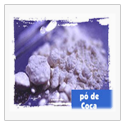|
|||||||||||||||||||
|
Types of Drugs
Cocaine
Two varieties of the plant dominate the market: huanaco, Bolivian coca leaf oval and brownish-green, and Peruvian coca, the much smaller leaves and pale green, which contains much alkaloid plants that thrive in Bolivia. Coca acclimatized in Java, in addition to alkaloids common to other varieties of Atropa cocaine has increased by four crystalline glycogen. The drug also can be obtained from a bush akin to Erythroxylon coca - the epadu, which grows in the Amazon and has been used for centuries by Indians of the region. In the Inca civilization, the use of coca was controlled personally by the emperor. The greatest privilege that could get an Inca was to win the right to chew coca leaves, and the nobles were often buried with a generous supply of leaves to supply them in paradise Inca. Chewed, coca leaves produce euphoria and enormous capacity for work. In the highlands of the Andes, the custom of chewing coca continues today among the people, helping them to address the problems of altitude and harsh climate. Cocaine itself, or cocaine hydrochloride, is a white, bitter and odorless, in the form of crystals or powder, and can be drunk, snorted or injected. Despite the short period of its existence, history records the famous drug users, as Sigmund Freud, Pope Leo XIII and writer Conan Doyle, creator of the famous detective Sherlock Holmes, which in turn also liked cocaine. At present, the drug is in widespread use not only among the movie stars, music and television, but also gaining consumers between executives and middle class in general. According to Veja, Brazil, typical users are between 25 and 40 years of age, Cz earnings above $ 15,000 (May-86) and can be advertisers, journalists, fashion designers, or financial professionals, whose behavior is self -sufficient and elegantly aggressive. According to Time magazine, from 1979 to 1982, the number of cocaine users in the United States increased from 15 million to 22 million, and seems to keep growing. The primary properties of the drug to block impulse conduction in nerve fibers, when applied externally, producing a sense of shock and frostbite. The drug is also vessel constriction, ie, contracts blood vessels by inhibiting bleeding, and works as a local anesthetic, which is one of its uses in medicine. Ingested or inhaled, cocaine acts on the peripheral nervous system, inhibiting bone resorption, the nerves, norepinephrine (an organic substance similar to adrenaline). Thus, it enhances the effects of stimulation of nerves. The Cocaine is also a stimulant of the central nervous system, acting on it with effect similar to amphetamines. In the brain, the drug particularly affects the motor areas, producing severe agitation. The action of cocaine on the body is powerful but brief, lasting about half an hour, since the drug is rapidly metabolized by the body. Their aspirations for a long period damages the mucosa and nasal tissues and may even cause perforation of the septum. Regularly consumed high doses cause bleeding from the nose and persistent coryza, and paleness, cold sweats, convulsions, fainting and respiratory arrest. The amount necessary to cause an overdose varies from person to person, and the fatal dose is 0.2 to 1.5 grams of pure cocaine. The possibility of overdose, however, is greater when the drug is injected directly into the bloodstream. The effect of cocaine can lead to an increase of excitability, anxiety, high blood pressure, nausea and even hallucinations. A U.S. report states that a peculiar characteristic of paranoid psychosis as a result of cocaine abuse, is a type of hallucination in which ants, insects or snakes imaginary seem to be heading over or under the skin of the cokehead. Coca-Cola, one of the most popular soft drinks, was originally a beverage made with coca leaves and sold as an "extraordinary therapeutic agent for all the ills from melancholy to insomnia. Legal complications, however, meant that from 1906 to pass the refrigerant used in your formula descocainadas coca leaves. |
||||||||||||||||||

 Synthesized in 1859, cocaine originates from the plant Erythroxylon coca, a shrub native to Bolivia and Peru (also cultivated in Java and Sri Lanka), whose chemical composition are the alkaloid cocaine, and anamila Truxillina (or Cocamina ).
Synthesized in 1859, cocaine originates from the plant Erythroxylon coca, a shrub native to Bolivia and Peru (also cultivated in Java and Sri Lanka), whose chemical composition are the alkaloid cocaine, and anamila Truxillina (or Cocamina ).